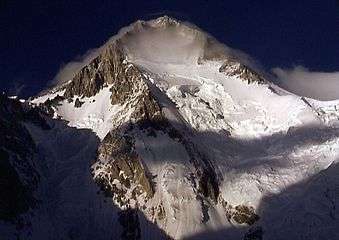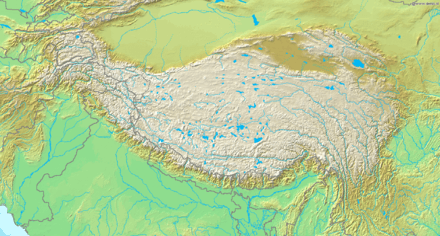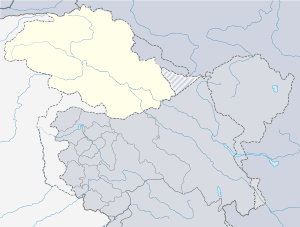Gasherbrum I
| Gasherbrum I | |
|---|---|
| Hidden Peak | |
 Gasherbrum I in 2001 | |
| Highest point | |
| Elevation |
8,080 m (26,510 ft) [1][2] Ranked 11th |
| Prominence | 2,155 m (7,070 ft) [1] |
| Isolation | 24 kilometres (15 mi) |
| Listing |
Eight-thousander Ultra |
| Coordinates | 35°43′28″N 76°41′47″E / 35.72444°N 76.69639°ECoordinates: 35°43′28″N 76°41′47″E / 35.72444°N 76.69639°E |
| Geography | |
| Parent range | Karakoram |
| Climbing | |
| First ascent |
July 5, 1958 by an American team (First winter ascent 9 March 2012 Adam Bielecki and Janusz Gołąb) |
| Easiest route | snow/ice climb |
Gasherbrum I (Urdu: گاشر برم -1; simplified Chinese: 加舒尔布鲁木I峰; traditional Chinese: 加舒爾布魯木I峰; pinyin: Jiāshūěrbùlǔmù I Fēng), surveyed as K5 and also known as Hidden Peak, is the 11th highest mountain in the world at 8,080 metres (26,510 ft) above sea level. It is located on the Pakistani–Chinese border in Gilgit–Baltistan region of Pakistan and Xinjiang region of China. Gasherbrum I is part of the Gasherbrum massif, located in the Karakoram region of the Himalaya. Gasherbrum is often claimed to mean "Shining Wall", presumably a reference to the highly visible face of the neighboring peak Gasherbrum IV; but in fact it comes from "rgasha" (beautiful) + "brum" (mountain) in Balti, hence it actually means "beautiful mountain."
Gasherbrum I was designated K5 (meaning the 5th peak of the Karakoram) by T.G. Montgomerie in 1856 when he first spotted the peaks of the Karakoram from more than 200 km away during the Great Trigonometric Survey of India. In 1892, William Martin Conway provided the alternate name, Hidden Peak, in reference to its extreme remoteness.
Gasherbrum I was first climbed on July 5, 1958 by Pete Schoening and Andy Kauffman of an eight-man American expedition led by Nicholas B. Clinch, Richard K. Irvin, Tom Nevison, Tom McCormack, Bob Swift and Gil Roberts were also members of the team.[3]:210-212
Timeline
- 1934 - A large international expedition, organized by the Swiss G.O. Dyhrenfurth, explores Gasherbrum I and II. Two climbers get to 6,300 m (20,670 ft).[4]
- 1936 - A French expedition gets to 6,900 m (22,640 ft).
- 1958 - An American team led by Nicholas Clinch makes the first ascent, via Roch ridge.[3]:208
- 1975 - Reinhold Messner and Peter Habeler reached the summit on a new route (northwest route) in pure alpine style (first time on an 8000-metre peak) taking three days total.[3]:212 One day later, a team of three led by Austrian Hanns Schell reached the summit on the American route.[3]:213
- 1977 - The fourth successful ascent by two Slovenians (Nejc Zaplotnik and Andrej Stremfelj), again on a new route. Team member Drago Bregar died.[3]:213
- 1980 - Frenchmen Maurice Barrard and Georges Narbaud[3]:213 are successful with the fifth ascent and pass the South Ridge for the first time.[4]
- 1981 - A Japanese team follows the Clinch route with fixed ropes for the sixth successful ascent.[3]:214[4]
- 1982 - Michael Dacher, Siegfried Hupfauer and Günter Sturm of a German expedition summit via a new route on the north face. In the same year, French Marie-José Valençot is the first woman who reaches the summit. Her husband, Sylvain Saudan from Switzerland, performs the first ski descent from the top of an 8000-metre peak to base camp.
- 1983 - Jerzy Kukuczka with Wojciech Kurtyka, new route. Alpine style ascent without the aid of oxygen.
- 1983 - Teams from Switzerland and Spain are successful.
- 1984 - Reinhold Messner and Hans Kammerlander traverse Gasherbrum II and Gasherbrum I without returning to base camp in between
- 1985 - Solo ascent by Benoît Chamoux. On July 14, the Italian Giampiero Di Federico (solo ascent) opens a new route on the north-west face.[5]
- 1997 - Magnus Rydén and Johan Åkerström reach the summit.
- 2003 - 19 people reach the summit, 4 deaths, including Mohammad Oraz.[6]
- 2012 - March 9, Adam Bielecki (Poland) and Janusz Gołąb (Poland) made the first winter ascent. The ascent was made without the aid of supplementary oxygen.[7] The same day, three climbers from a different expedition — Austrian Gerfried Goschl, Swiss Cedric Hahlen and Pakistani Nisar Hussain Sadpara — went missing, never to be found again. They were trying to ascend via a new route and are considered to have been blown off by strong winds.[8]
- 2013 - 7 July, Artur Hajzer died after falling in the Japanese Coloir after an attempt to reach the summit. [9]
- 2013 - 21 July, Spaniards Abel Alonso, Xebi Gomez and Álvaro Paredes climbed to the top to then disappear while descending after a storm.[10]
- 2017 - 30 July, in an alpine style six-day ascent without supplementary oxygen, Czechs Marek 'Mára' Holeček and Zdeněk Hák established a new route named Satisfaction! (in memory of Zdeněk Hrubý) up the Southwest Face.[11]
See also
Bibliography
- Carter, H. Adams (1975). "Balti Place Names in the Karakoram". American Alpine Journal. 49: 53.
- Clinch, Nicholas (December 1982). A Walk in the Sky: Climbing Hidden Peak. Seattle, WA, USA: The Mountaineers. ISBN 0-89886-042-3.
- Fanshawe, Andy; Venables, Stephen (March 1996). Himalaya alpine-style: the most challenging routes on the highest peaks. Seattle, WA, USA: Mountaineers Books. ISBN 0-34064-931-3.
Notes and references
- 1 2 "Gasherbrum I". Peakbagger.com. Retrieved 2014-08-24.
- ↑ "Trekking Routes - Highest peaks". cknp.org. Retrieved 2014-08-24.
- 1 2 3 4 5 6 7 Clinch, Nicholas (1982). A Walk in the Sky: Climbing Hidden Peak. New York, Vancouver: The Mountaineers. ISBN 0898860423.
- 1 2 3 "Gasherbrum I: Some background and History". k2news.com. Retrieved 2014-01-04.
- ↑ Fanshawe & Venables "Himalaya alpine-style"
- ↑ "Everest Summiter Mohammad Oraz death/Iranian expedition". k2news.com. September 2003. Retrieved 2014-01-04.
- ↑ "Polish Winter Himalayan Mountaineering 2010-2015". Polishwinterhimalaism.pl. March 9, 2012. Archived from the original on July 8, 2012. Retrieved 2012-08-17.
- ↑ "Three missing mountaineers feared dead, rescue mission called off". dawn.com. March 15, 2012. Retrieved 2012-03-15.
- ↑ Crothers, David (16 July 2013). "Iconic Polish Climber Artur Hajzer Dies on Gasherbrum I". Retrieved 25 July 2018.
- ↑ "Se da por desaparecidos a Xevi Góméz, Álvaro Paredes y Abel Alonso en el G1". 26 July 2013. Retrieved 25 July 2018.
- ↑ "Gasherbrum I SW Face, big new route by Marek Holeček and Zdeněk Hák". Planet Mountain. 11 August 2017. Retrieved 1 May 2018.


